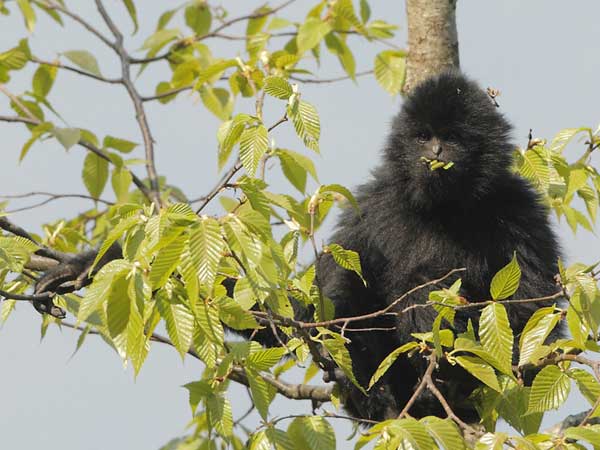Last of the gibbons
Updated: 2013-12-18 09:12
By Chen Liang (China Daily)
|
|||||||||||
 |
|
A male western black-crested gibbon feeds on tender leaves. Zhao Chao / for China Daily |
The Hainan gibbon, found only in the island province, is also one of the world's most endangered primate species. The newest figure is two families of 23 mammals, Long says, all residing in Bawangling National Nature Reserve. In 2003, there were only two groups of 13 gibbons.
Northern white-cheeked gibbon, with a population of more than 2,000 in southern Yunnan in the 1960s and a population of about seven groups of 40 animals in 1989, has not been sighted for many years. "It might be extinct already in the country," Long says.
Hoolock gibbon is distributed in the country mainly in Yingjiang, Tengchong and Baoshan of western Yunnan, with a population of 150 in 40 families.
The white-handed gibbon that lives in the southernmost part of Yunnan had three families of about 10 mammals in 1992, and hasn't been spotted for several years. "The status of the western black-crested gibbon is the only one that is not so gloomy," Long says.
About 150 groups of 700-800 western black-crested gibbons are living on the Ailao Mountains, of which an estimated 500 gibbons in 124 groups were recorded in the Ailao Mountains nature reserves within Xinping county, in a survey done in 2009 and 2010.
"Thus, Xinping has the world's largest population of western black-crested gibbon with the highest density," says Yang Xianming, director of the Ailao Mountains National Nature Reserve's Xinping Bureau.
While the other gibbons living in the country face serious threats of habitat loss and poaching, Yang says, the western black-crested gibbons still dominate the country's largest primitive middle-mountain moist broadleaf forests on the Ailao Mountains. In Xinping, moist broadleaf forests cover more than 30,000 hectares, Yang says.
Related Stories
For the love of tigers, she sets them free 2013-12-10 09:36
Cute pets in their own 'Downton Abbey' 2013-12-13 14:35
Excellent animal photographic works 2013-12-11 16:42
Animation more than a fantasy 2013-10-05 07:38
Get up close with anime characters 2013-09-15 07:33
Today's Top News
Monaco and Shanghai jointly to grow yachting biz
Vast deposits of 'flammable ice' found
System for organ donors test
Hukou reforms target 2020: official
Russia to bail out Ukraine for $15 billion
Merkel sworn in for a third term
Japan seeks bigger role for military
US budget deal clears crucial vote
Hot Topics
Lunar probe , China growth forecasts, Emission rules get tougher, China seen through 'colored lens', International board,
Editor's Picks

|

|

|

|

|

|





